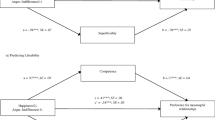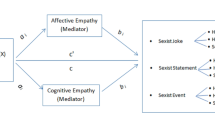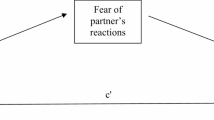Abstract
The present study investigated how cheating experience influences perception of others’ infidelity. Using vignette characters, we explored the hypothesis that a participant’s experience cheating on a partner and gender of vignette character moderate gender-differentiated perceptions of infidelity (i.e., men reporting more accepting attitudes toward infidelity than women). Participants (N = 320) were asked a series of questions evaluating both how ‘acceptable’ and ‘forgivable’ was a vignette character’s infidelity. Men and women with prior experience cheating found the cheating vignette character of their same gender significantly more acceptable and forgivable than the unfaithful character of the other gender. Participants who reported no history of infidelity found infidelity as generally unacceptable, regardless of character gender.


Similar content being viewed by others
References
Allen, E. S., & Atkins, D. C. (2005). The multidimensional and developmental nature of infidelity: Practical applications. Journal of Clinical Psychology, 61, 1371–1382.
Allen, E. S., Atkins, D. C., Baucom, D. H., Snyder, D. K., Gordon, K. C., & Glass, S. P. (2005). Intrapersonal, interpersonal, and contextual factors in engaging in and responding to extramarital involvement. Clinical Psychology Science and Practice, 12, 101–130.
Allen, E. S., & Baucom, D. H. (2006). Dating, marital, and hypothetical extradyadic involvements: How do they compare? Journal of Sex Research, 43, 307–317.
Amato, P. R., & Previti, D. (2003). People’s reasons for divorcing: Gender, social class, the life course, and adjustment. Journal of Family Issues, 24, 602–626.
Atkins, D. C., Yi, J., Baucom, D. H., & Christensen, A. (2005). Infidelity in couples seeking marital therapy. Journal of Family Psychology, 19, 470–473.
Atwood, J. D., & Seifer, M. (1997). Extramarital affairs and constructed meanings: A social constructionist therapeutic approach. The American Journal of Family Therapy, 25, 55–75.
Berman, M. I., & Frazier, P. A. (2005). Relationship power and betrayal experience as predictors of reactions to infidelity. Personality and Social Psychology Bulletin, 31, 1617–1627.
Bird, M. H., Butler, M. H., & Fife, S. T. (2007). The process of couple healing following infidelity: A qualitative study. Journal of Couple and Relationship Therapy, 6, 1–25.
Buss, D. M., Larsen, R. J., & Westen, D. (1996). Sex differences in jealousy: Not gone, not forgotten, and not easily explained by alternative hypotheses. Psychological Science, 7, 373–375.
Buss, D. M., Larsen, R. J., Westen, D., & Semmelroth, J. (1992). Sex differences in jealousy: Evolution, physiology, and psychology. Psychological Science, 3, 251–255.
Buss, D. M., & Shackelford, T. K. (1997). Susceptibility to infidelity in the first year of marriage. Journal of Research in Personality, 31, 193–221.
Buunk, B. P., & Dijkstra, P. (2004). Gender differences in rival characteristics that evoke jealousy in response to emotional versus sexual infidelity. Personal Relationships, 11, 395–408.
Caprio, F. S. (1953). Marital infidelity. Secaucus, NJ: Citadel Press.
Centers for Disease Control and Prevention Department of Health and Human Services (2002). Cohabitation, marriage, divorce, remarriage in the United States. Retrieved March 26, 2007, from http://www.cdc.gov/nchs/data/series/sr_23/sr23_022.pdf.
Charny, I. W., & Parnass, S. (1995). The impact of extramarital relationships on the continuation of marriages. Journal of Sex and Marital Therapy, 21, 100–115.
Christensen, H. T. (1973). Attitudes toward marital infidelity: A nine-cultural sampling of university student opinion. Journal of Comparative Family Studies, 4, 197–214.
DeMaris, A. (2009). Distal and proximal influences on the risk of extramarital sex: A prospective study of longer duration marriages. Journal of Sex Research, 46, 597–607. doi:10.1080/00224490902915993.
DeSteno, D., Bartlett, M. Y., Braverman, J., & Salovey, P. (2002). Sex differences in jealousy: Evolutionary mechanism or artifact of measurement? Journal of Personality and Social Psychology, 83, 1103–1116.
DeSteno, D. A., & Salovey, P. (1996). Evolutionary origins of sex differences in jealousy? Questioning the ‘fitness’ of the model. Psychological Science, 7, 376–377.
Drigotas, S. M., Safstrom, C. A., & Gentilia, T. (1999). An investment model prediction of dating infidelity. Journal of Personality and Social Psychology, 77, 509–524.
Edlund, J. E., Heider, J. D., Scherer, C. R., Fare, M., & Sagarin, B. J. (2006). Sex differences in jealousy in response to actual infidelity. Evolutionary Psychology, 4, 462–470.
Feldman, S. S., & Cauffman, E. (1999). Your cheatin’ heart: Attitudes, behaviors, and correlates of sexual betrayal in late adolescents. Journal of Research on Adolescence, 9, 227–252.
Festinger, L., & Carlsmith, J. M. (1959). Cognitive consequences of forced compliance. Journal of Abnormal and Social Psychology, 58, 203–210.
Gallagher, M. (2001). What is marriage for? The public purposes of marriage law. Retrieved March 4, 2007 http://www.marriagedebate.com/pdf/What%20is%20Marriage%20For.pdf.
Gonyea, J. L. J. (2004). Internet sexuality: Clinical implications for couples. The American Journal of Family Therapy, 32, 375–390.
Gould, T. (2000). The lifestyle: A look at the erotic rites of swingers. Buffalo, NY: Firefly books.
Greene, B. L., Lee, R. R., & Lustig, N. (1974). Conscious and unconscious factors in marital infidelity. Medical Aspects of Human Sexuality, 8, 97–105.
Haavio-Mannila, E., & Kontula, O. (2003). Single and double standards in Finland, Estonia, and St Petersburg. Journal of Sex Research, 40, 36–49.
Hall, J. H., & Fincham, F. D. (2006). Relationship dissolution following infidelity: The roles of attributions and foregiveness. Journal of Social and Clinical Psychology, 25, 508–522.
Hall, J. H., & Fincham, F. D. (2009). Psychological distress: Precursor or consequence of dating infidelity? Personality and Social Psychology Bulletin, 35, 143–159.
Hansen, G. L. (1987). Extradyadic relations during courtship. Journal of Sex Research, 23, 382–390.
Harris, C. R. (1996). Gender, jealousy, and reason. Psychological Science, 7, 364–366.
Harris, C. R. (2002). Sexual and romantic jealousy in heterosexual and homosexual adults. Psychological Science, 13, 7–12.
Harris, C. R. (2003a). Factors associated with jealousy over real and imagined infidelity: An examination of the social-cognitive and evolutionary psychology perspectives. Psychology of Women Quarterly, 27, 319–329.
Harris, C. R. (2003b). A review of sex differences in sexual jealousy, including self-report data, psychophysiological responses, interpersonal violence, and morbid jealousy. Personality and Social Psychology Review, 7, 102–128.
Harris, C. R. (2005). Male and female jealousy, still more similar than different: Reply to Sagarin. Personality and Social Psychology Review, 9, 26–86.
Harris, C. R., & Christenfeld, N. (1996). Jealousy and rational responses to infidelity across gender and culture. Psychological Science, 7, 378–379.
Huebner, D. M., Neilands, T. B., Rebchook, G. M., & Kegeles, S. M. (2011). Sorting through chickens and eggs: A longitudinal examination of the associations between attitudes, norms, and sexual risk behavior. Health Psychology, 30, 110–118.
Hunyady, O., Josephs, L., & Jost, J. T. (2008). Priming the primal scene: Betrayal trauma, narcissim, and attitudes toward sexual infidelity. Self and Identity, 7, 278–294.
Knox, D., Zusman, M. E., Kaluzny, M., & Sturdivant, L. (2000). Attitudes and behavior of college students toward infidelity. College Student Journal, 34, 162–164.
Lalasz, C. B., & Weigel, D. J. (2011). Understanding the relationship between gender and extradyadic relations: The mediating role of sensation seeking on intentions to engage in sexual infidelity. Personality and Individual Differences, 50, 1079–1083.
Linquist, L., & Negy, C. (2005). Maximizing the experiences of an extra relational affair: An unconventional approach to a common social convention. Journal of Clinical Psychology, 61, 1421–1428.
Mackay, J. (2001). Global sex: Sexuality and sexual practices around the world. Sexual and Relationship Therapy, 16, 71–82.
Mattingly, B. A., Wilson, K., Clark, E. M., Bequette, A. W., & Weidler, D. J. (2010). Foggy faithfulness: Relationship quality, religiosity, and the perceptions of dating infidelity scale in an adult sample. Journal of Family Issues, 30. doi:10.1177/0192513X10362348.
Olson, L. R., Cadge, W., & Harrison, J. T. (2006). Religion and public opinion about same-sex marriages. Social Science Quarterly, 87, 340–360.
Previti, D., & Amato, P. R. (2004). Is infidelity a cause or consequence of poor marital quality? Journal of Social and Personal Relationships, 21, 217–230.
Prins, K. S., Buunk, B. P., & Van Yperen, N. W. (1993). Equity, normative disapproval and extramarital relationships. Journal of Social and Personal Relationships, 10, 39–53.
Riviere, J. (1932). Jealousy as a mechanism of defense. International Journal of Psycho-Analysis, 13, 414–424.
Roscoe, B., Cavanaugh, L. E., & Kennedy, D. R. (1988). Dating infidelity: Behavior, reasons, and consequences. Adolescence, 23, 35–43.
Rubin, R. H. (2001). Alternative lifestyles revisited, or whatever happened to swingers, group marriages, and communes? Journal of Family Issues, 22, 711–726.
Sabini, J., & Green, M. C. (2004). Emotional responses to sexual and emotional infidelity: Constants and differences across genders, samples, and methods. Personality and Social Psychology Bulletin, 30, 1375–1388.
Sagarin, B. J. (2005). Reconsidering evolved sex differences in jealousy: Comment on Harris (2003). Personality and Social Psychology Review, 9, 62–75.
Sagarin, B. J., Becker, D. V., Guadagno, R. E., Nicastle, L. D., & Millevoi, A. (2003). Sex differences (and similarities) in jealousy: The moderating influence of infidelity experience and sexual orientation of the infidelity. Evolution and Human Behavior, 24, 17–23.
Sagarin, B. J., & Guadagno, R. E. (2004). Sex differences in the context of extreme jealousy. Personal Relationships, 11, 319–328.
Schick, V., Rosenberger, J. G., Herbenick, D., Calabrese, S. K., & Reece, M. (2012). Bidentity: Sexual behavior/identity congruence and women’s sexual, physical, and mental well-being. Journal of Bisexuality, 12, 178–197.
Schmitt, D. P., & Shackelford, T. K. (2003). Nifty ways to leave your lover: The tactics people use to entice and disguise the process of human mate poaching. Personality and Social Psychology Bulletin, 29, 1018–1035.
Schützwohl, A. (2005). Sex differences in jealousy: The processing of cues to infidelity. Evolution and Human Behavior, 26, 288–299.
Schützwohl, A. (2006). Sex differences in jealousy: Information search and cognitive preoccupation. Personality and Individual Differences, 40, 285–292.
Shackelford, T. K., & Buss, D. M. (2000). Marital satisfaction and spousal cost- infliction. Personality and Individual Differences, 28, 917–928.
Shackelford, T. K., LeBlanc, G. J., & Drass, E. (2000). Emotional reactions to infidelity. Cognition and Emotion, 14, 643–659.
Shackelford, T. K., Voracek, M., Schmitt, D. P., Buss, D. M., Weekes-Shackelford, B. A., & Michalski, R. L. (2004). Romantic jealousy in early adulthood and in later life. Human Nature, 15, 283–300.
Sheppard, V. J., Nelson, E. S., & Andreoli-Mathie, V. (1995). Dating relationships and infidelity: Attitudes and behavior. Journal of Sex and Marital Therapy, 21, 202–212.
Stebleton, M. J., & Rothenberger, J. H. (1993). Truth or consequences: Dishonesty in dating and HIV/AIDS-related issues in a college-age population. Journal of American College Health, 42, 51–54.
Stone, E. A., Goetz, A. T., & Shackelford, T. K. (2005). Sex differences and similarities in preferred mating arrangements. Sexualities, Evolution, & Gender, 7, 269–276.
Thompson, A. P. (1982). Extramarital relations: Gaining greater awareness. Personnel Guide Journal, 61, 102–105.
Thornton, A., & Young De-Marco, L. (2001). Four decades of trends in attitudes toward family issues in the United States: The 1960s through the 1990s. Journal of Marriage & the Family, 63, 1009–1037.
Treas, J., & Giesen, D. (2000). Sexual infidelity among married and cohabitating Americans. Journal of Marriage & the Family, 62, 48–60.
United Nations Population Division Department of Economic and Social Affairs. (2000). World Marriage Patterns 2000. Retrieved March 3, 2007, from http://www.un.org/esa/population/publications/worldmarriage/worldmarriagepatterns2000.pdf.
Varga, C. M., Gee, C. B., & Munro, G. (2011). The effects of sample characteristics and experience with infidelity on romantic jealousy. Sex Roles, 65, 854–866.
Weis, D. L., & Felton, J. R. (1987). Marital exclusivity and the potential for marital conflict. Social Work, 32, 45–49.
Whitty, M. T. (2003). Pushing the wrong buttons: Men’s and women’s attitudes toward online and offline infidelity. CyberPsychology and Behavior, 6, 569–579.
Wiederman, M. W., & Allgeier, E. R. (1993). Gender differences in sexual jealousy: Adaptionist or social learning explanation? Ethology & Sociobiology, 14, 115–140.
Wiederman, M. W., & Hurd, C. (1999). Extradyadic involvement during dating. Journal of Social and Personal Relationships, 16, 256–274.
Young, K. S., Griffin-Shelley, E., Cooper, A., O’Mara, J., & Buchanan, J. (2000). Online infidelity: A new dimension in couple relationships with implications for evaluation and treatment. Sexual Addiction & Compulsivity, 7, 59–74.
Author information
Authors and Affiliations
Corresponding author
Rights and permissions
About this article
Cite this article
Sharpe, D.I., Walters, A.S. & Goren, M.J. Effect of Cheating Experience on Attitudes toward Infidelity. Sexuality & Culture 17, 643–658 (2013). https://doi.org/10.1007/s12119-013-9169-2
Published:
Issue Date:
DOI: https://doi.org/10.1007/s12119-013-9169-2




